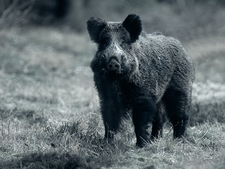-
Topics
subnavigation
Topics
Electromagnetic fields
- What are electromagnetic fields?
- Static and low-frequency fields
- Radiation protection relating to the expansion of the national grid
- High-frequency fields
- Radiation protection in mobile communication
Optical radiation
Ionising radiation
- What is ionising radiation?
- Radioactivity in the environment
- Where does radioactivity occur in the environment?
- What is the level of natural radiation exposure in Germany?
- Air, soil and water
- Radon
- Foodstuffs
- What radionuclides can be found in food?
- Natural radioactivity in food
- Radiation exposure via food intake
- Radiation exposure of mushrooms and game
- Building materials
- Relics
- Industrial residues (NORM)
- BfS laboratories
- Applications in medicine
- Applications in daily life and in technology
- Effects
- What are the effects of radiation?
- Effects of selected radioactive materials
- Consequences of a radiation accident
- Cancer and leukaemia
- Genetic radiation effects
- Individual radiosensitivity
- Epidemiology of radiation-induced diseases
- Ionising radiation: positive effects?
- Risk estimation and assessment
- Radiation protection
- Nuclear accident management
- Service offers
-
The BfS
subnavigation
The BfS
- About us
- Science and research
- Laws and regulations
- BfS Topics in the Bundestag
- Links
Radioactive contamination of mushrooms and wild game
- As a result of the Chernobyl reactor accident, certain species of mushrooms and wild game are still highly contaminated with caesium-137 in some areas of Germany.
- The contamination of mushrooms depends on both the caesium-137 content near the mycelium and the special accumulation capacity of the respective mushroom species.
- Depending on the region and the animal species, the contamination level of wild game may differ substantially.
- Those who wish to reduce their personal exposure should not eat wild game hunted or mushrooms self-picked in the most affected areas of Germany.
As a result of the Chernobyl reactor accident, certain species of mushrooms and wild game are still highly contaminated with caesium-137 in some areas of Germany. This applies especially to Southern Germany – in particular Southern Bavaria and the Bavarian Forest. In the last years values of up to several thousand becquerel per kilogram were measured in wild game and certain edible mushrooms.
In Germany it is not permitted to market food with a radiocaesium content of more than 600 becquerel per kilogram. This limit does not apply for private use.
If wild game or wild growing mushrooms are consumed in usual amounts, the additional radiation exposure is comparatively low but it can be avoided. Those who wish to reduce their personal exposure should not eat wild game self-hunted or mushrooms self-picked in the most affected areas of Germany.
Edible wild mushrooms
The level of contamination of edible wild mushrooms varies depending on the species and the place they grow. At the sampling areas examined by the BfS
- two-tone wood wax (Hygrophorus unicolor),
- Hygrophorus discoideus,
- grey knight (Tricholoma terreum),
- terracotta hedgehog (Hydnum rufescens),
- wood hedgehog (Hydnum repandum),
- bay bolete (Xerocomus badius) and
- umber-zoned ringless amanita (Amanita umbrinolutea)
reached activity contents of more than 1,000 becquerel per kilogram of caesium-137 in the last three years (2014 to 2016).
The contamination of mushrooms depends on both the caesium-137 content near the mycelium and the special accumulation capacity of the respective mushroom species. The contamination of a mushroom species is very site specific and varies even within the same area a lot more than from year to year.
Wild game
Depending on the region and the animal species, the contamination level of wild game may differ substantially. Measurement data collected within the scope of the national measurement program (IMIS) during the last three years (2014 to 2016) contain
- up to about 2,500 becquerel per kilogram for wild boar and
- 840 becquerel per kilogram for roe deer.
In most cases, however, substantially lower values were determined.
The strong differences between the various types of wild game are mainly due to the dietary behaviour of the individual animal species. Since the contamination of deer truffle, which grows below the surface and is fed on by wild boar, is extremely high (the values are more than ten times higher than those of edible mushrooms), meat of wild boar is clearly higher contaminated than the meat of other wild game species.
Contamination will decline over the medium-term
The fact that the contamination of food from forests may be significantly higher than that of agricultural products, is due to the diverse nature of forest soils and agriculturally used soils.
Radiocaesium migrates very slowly into deeper layers of forest soils. As a result of this migration and of the radioactive decay, the activity concentrations in mushrooms and wild game will gradually decrease in the next years.
State of 2017.09.05




